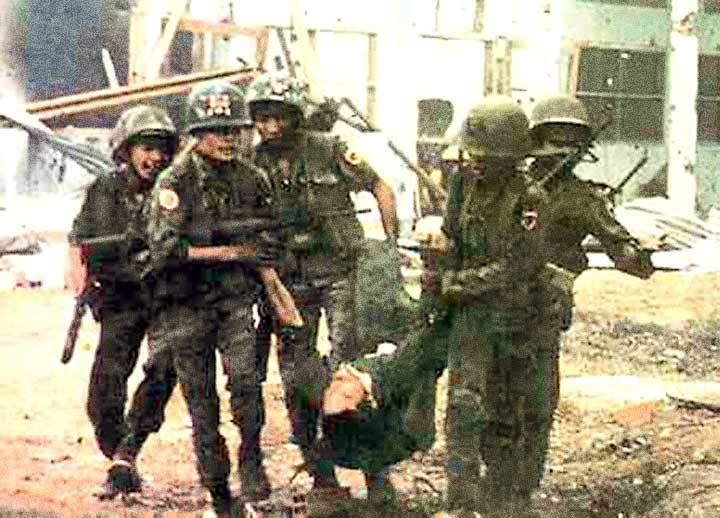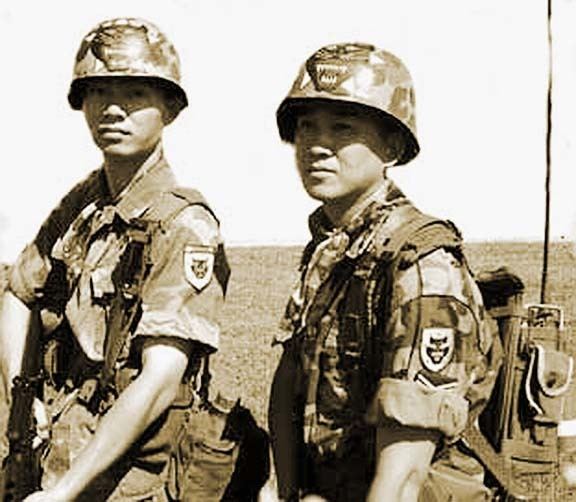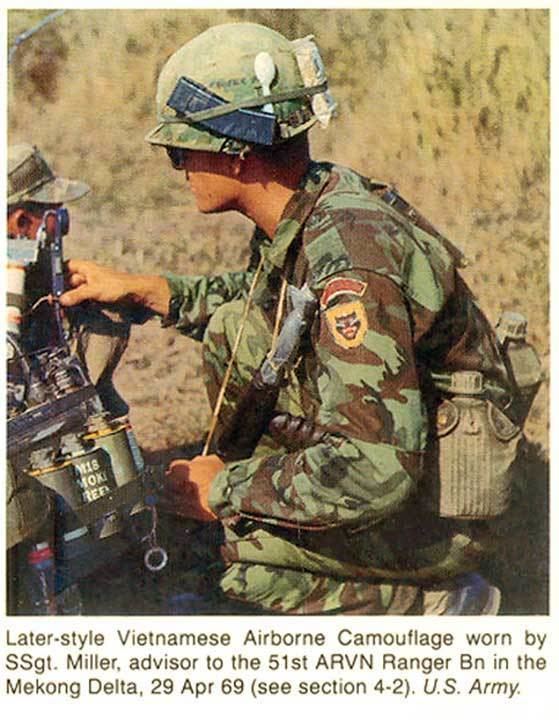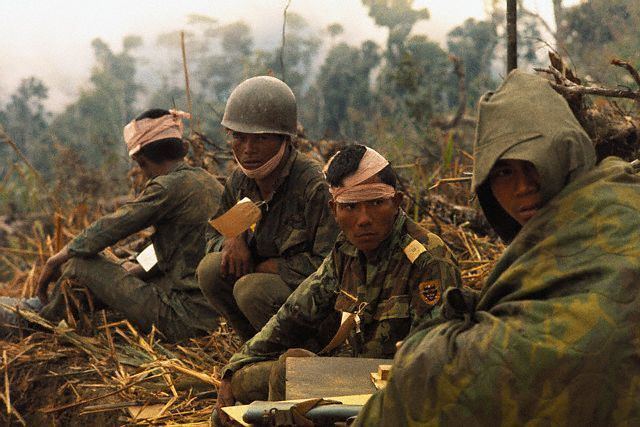Active 1951 – 1975 | Country South Vietnam | |
 | ||
Role Search and destroyCounter-insurgency Similar Republic of Vietnam Military F, Republic of Vietnam Marine Di, Army of the Republic of Vietnam, Army of the Republic of Vietnam, South Vietnam Air Force | ||
Vietnamese rangers
The Vietnamese Rangers, properly known in Vietnamese as the Biệt Động Quân, more commonly known as the ARVN Rangers, were the Rangers of the Army of the Republic of Vietnam. Trained and assisted by American Special Forces and Ranger advisers, the Vietnamese Rangers infiltrated beyond enemy lines in daring search and destroy missions. Initially trained as a counter-insurgency light infantry force by removing the fourth company each of the existing infantry battalions, they later expanded into a swing force capable of conventional as well as counter-insurgency operations.
Contents
- Vietnamese rangers
- Synd 08 02 69 south vietnamese rangers move in against vietcong in a village area
- History
- Uniforms and equipment
- Corps Ranger Liaisons
- Rangers
- Border Rangers
- The 81st Ranger Group
- Training
- References

Synd 08 02 69 south vietnamese rangers move in against vietcong in a village area
History

The French established a commando school in Nha Trang in 1951. After the American Military Assistance Advisory Group took over the military advisory role, the school was converted to a Ranger school in 1956. In 1960, when the Vietnam War began in earnest, the Vietnamese Rangers were formed. Rangers (Biet Dong Quan [BDQ]) initially organized into separate companies with US Army Rangers were assigned as advisers, initially as members of the Mobile Training Teams (MTTs), at Ranger Training Centers (RTC), and later at the unit level as members of the Military Advisory Command Vietnam (MACV). A small number of Vietnamese Ranger officers were selected to attend the U.S. Army Ranger School at Ft. Benning.

In 1962, BDQ companies were initially formed into counter-insurgency Special Battalions but by 1963 Ranger units were organized into battalions and their mission evolved from counter-insurgency to light infantry operations. During 1966, the battalions were formed into task forces, and five Ranger Group headquarters were created at corps level to provide command and control for tactical operations. The Ranger Group structure was maintained until 1970 as U.S. force reduction commenced. The Civilian Irregular Defense Group (CIDG) situated along the Laotian and Cambodian borders, formerly under control of 5th U.S. Special Forces Group, was integrated into the Ranger command. Thus, the Rangers assumed an expanded role of border defense. The conversion of CIDG camps to 37 combat battalions with 14,534 men, more than doubled the Ranger force size. Within the early 1970s before the fall of Saigon, the rangers lost its appeal. Although many wanted to join the ranks of the Rangers, the popularity of the Airborne and Marine divisions grew at a faster rate.

In the closing days of the war in 1975 most Ranger units were totally destroyed. Many fought back independently, refusing to surrender. In Saigon, Rangers fought until the morning of 30 April when they were ordered to lay down their arms, as their nation-The Republic of Vietnam capitulated to the communist force. Most of the Ranger officers were considered too dangerous by the communist government and sentenced to long periods of incarceration in the "re-education" camps.
Uniforms and equipment

The Rangers wore all the uniforms that the ARVN wore, however they were known for their tightly tailored OG-107's and camouflage uniforms. They wore a snarling black panther superimposed over a large yellow star painted in front of their helmets. The Rangers also wore brown/maroon berets worn to the left in the French-style with a badge containing a winged arrow in a wreath was worn over the right ear. This beret was also worn by American and Australian Army advisers with the unit.
Corps Ranger Liaisons
There were Ranger liaison platoons of 45 to 52 men assigned to each ARVN Corps/CTZ headquarters. They were supposed to insure the "proper use" of the Rangers.
Rangers
At their height in 1975 there were 54 Ranger battalions in 20 Groups. However, only 22 of these battalions, formed in 10 Groups, were actual Rangers while the rest were Border Rangers who were converted over during the Vietnamization from previous CIDG and MIKE Forces.
The following Ranger (Biêt Dông Quân) formations existed:
Additionally, during the Vietnamization of the CIDG and MIKE Forces, former CIDG units were namely given Ranger status and organized into groups mostly of 3 battalions each, but they were largely local forces without any special forces capabilities.
The 3rd, 5th, and 6th Ranger Groups, all operational in the III Corps area, were grouped together into the Third Ranger Command through which the ARVN attempted to form another division, but the lack of enough heavy weapons prevented this from happening.
Border Rangers
A further 33 Ranger Border Defense Battalions also existed in 1973. These were the former CIDG units formed by the Americans and totaled 14,365 men. Border Ranger Battalions were smaller than their Ranger counterparts with 465 men versus the 575 to 650 of regular Rangers.
In existence by March 1975 were also the following new formations in the Central Highlands, made up of mainly the former Ranger Border Defense Battalions being now consolidated into Ranger Groups of three battalion each:
The 81st Ranger Group
The 81st Rangers were a unique unit originally formed as part of the Project DELTA reaction force. Formed on 1 November 1964 as the 91st Airborne Ranger Battalion and consisted of three companies of Montagnards. A fourth company was added in 1965. It was reorganized in 1966 as the 81st Ranger Battalion by the "purging of non-Vietnamese" to make it more "effective". The 81st consisted of six all-Vietnamese companies. It was officially under LLDB command and not that of Ranger Command. It was actually under the direct control of Project DELTA although two companies were made available to the LLDB. Its primary mission was to provide airmobile reaction forces to aid in the extraction of recon teams and execute immediate exploitation raids on targets discovered by the teams. It was also used to reinforce SF camps under siege. During and after Tet it also fought in Saigon and handled urban fighting conditions quite well.
The 81st Ranger Battalion was later expanded to seven companies and renamed the 81st Ranger Group which was facilitated by the merger of Delta Teams with the existing three Ranger Companies. The entire unit was parachute trained and was under the direct control of the ARVN G-2.
In 1975 it was headquartered at Trang Lon, Tay Linh, and consisted of a Headquarters, seven Ranger and one Pathfinder company. Group strength varied from 920 to 1200 men.
The 91st/81st battalion continued to wear the old LLDB Green Beret instead of the Ranger Brown/Maroon Beret.
Training
Ranger courses were established at three training sites in May 1960: Da Nang, Nha Trang, and Song Mao. The original Nha Trang Training course relocated to Dục Mỹ in 1961 and would become the central Ranger-Biêt Dông Quân-Company and Battalion sized unit training was later established at Trung Lap; to ensure a consistently high level of combat readiness, BDQ units regularly rotated through both RTC's. Graduates of the school earned the Ranger badge with its distinctive crossed swords.
Ranger Training Centers conducted tough realistic training that enabled graduates to accomplish the challenging missions assigned to Ranger units. Known as the "steel refinery" of the ARVN, the centers conducted training in both jungle and mountain warfare.
